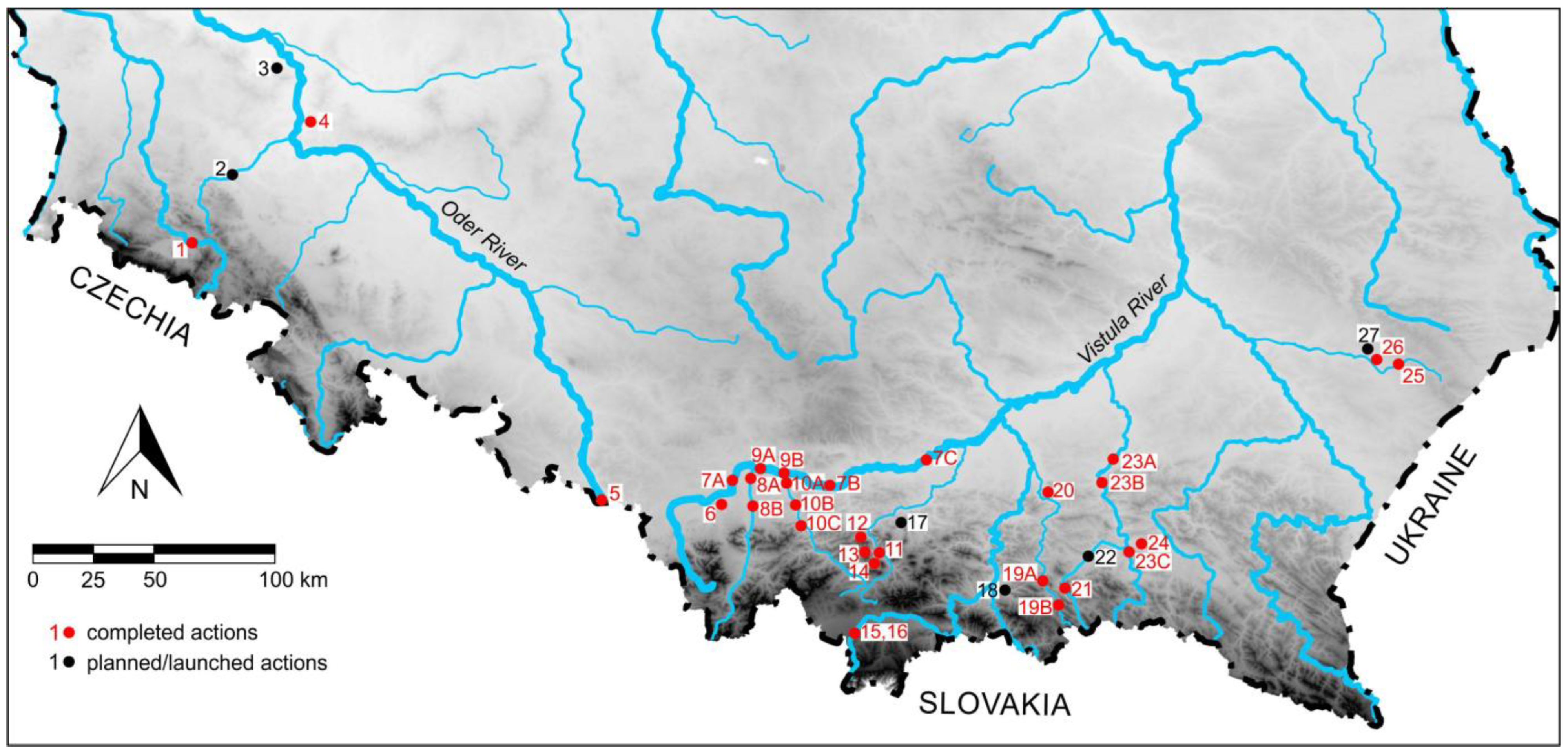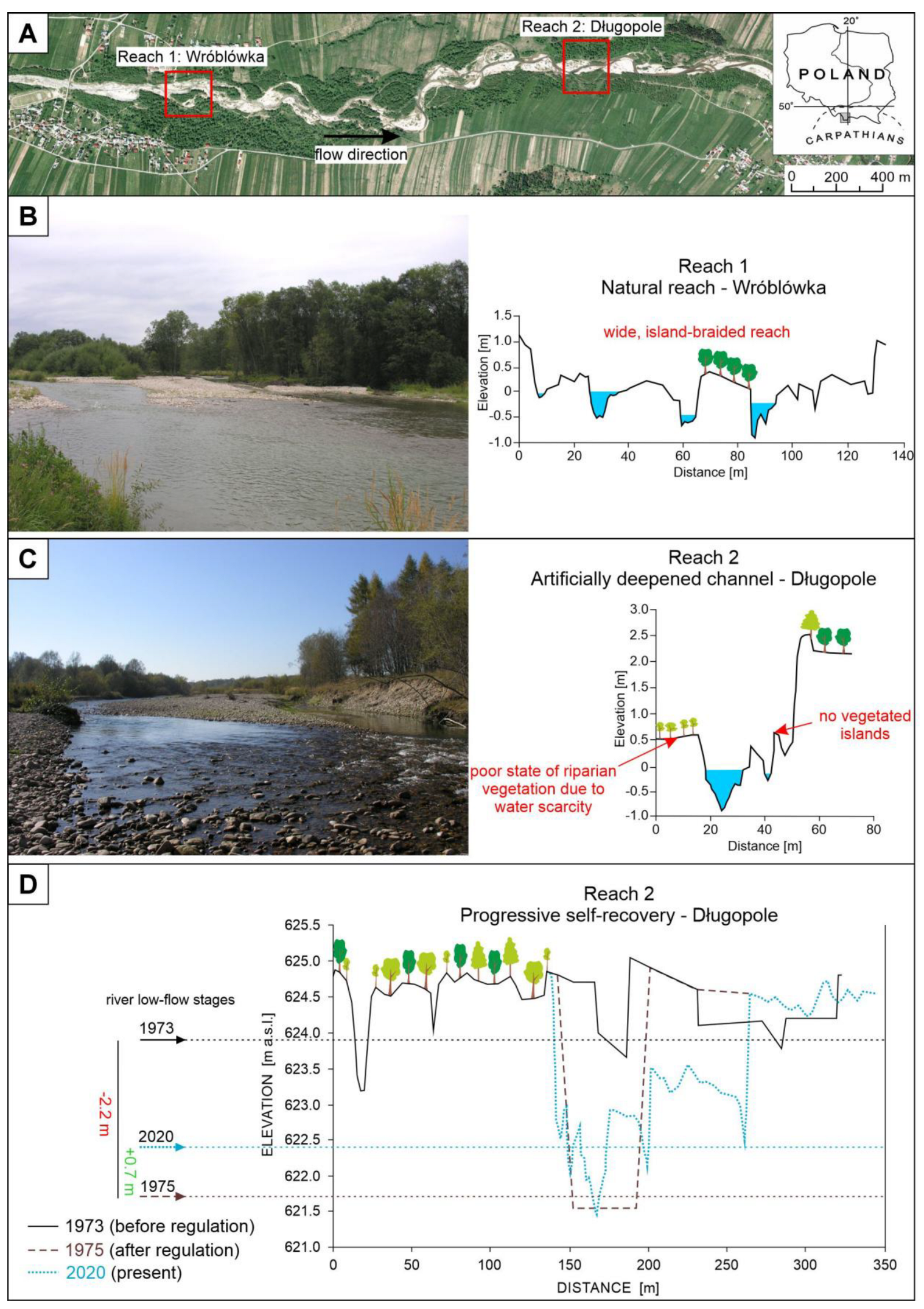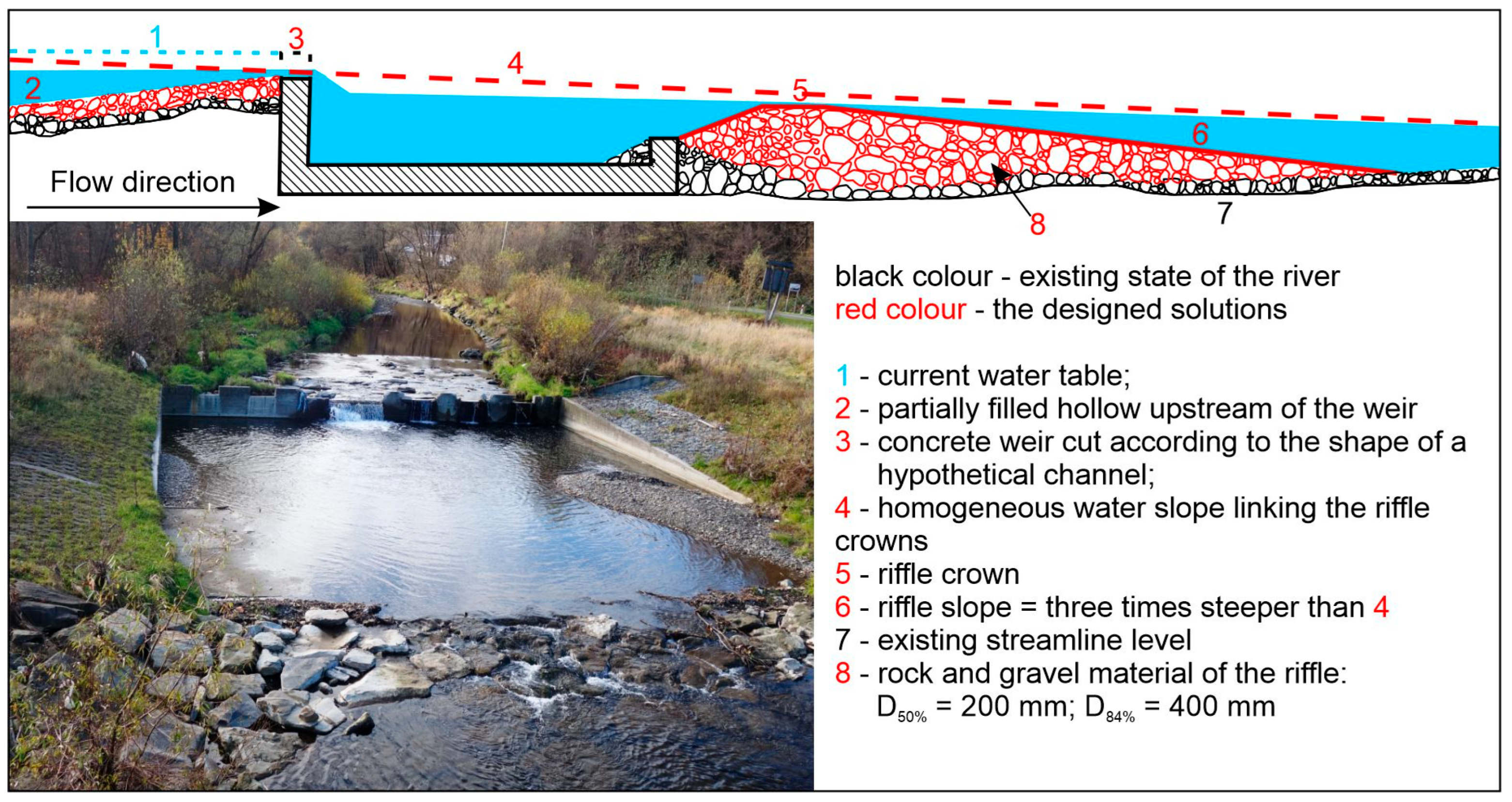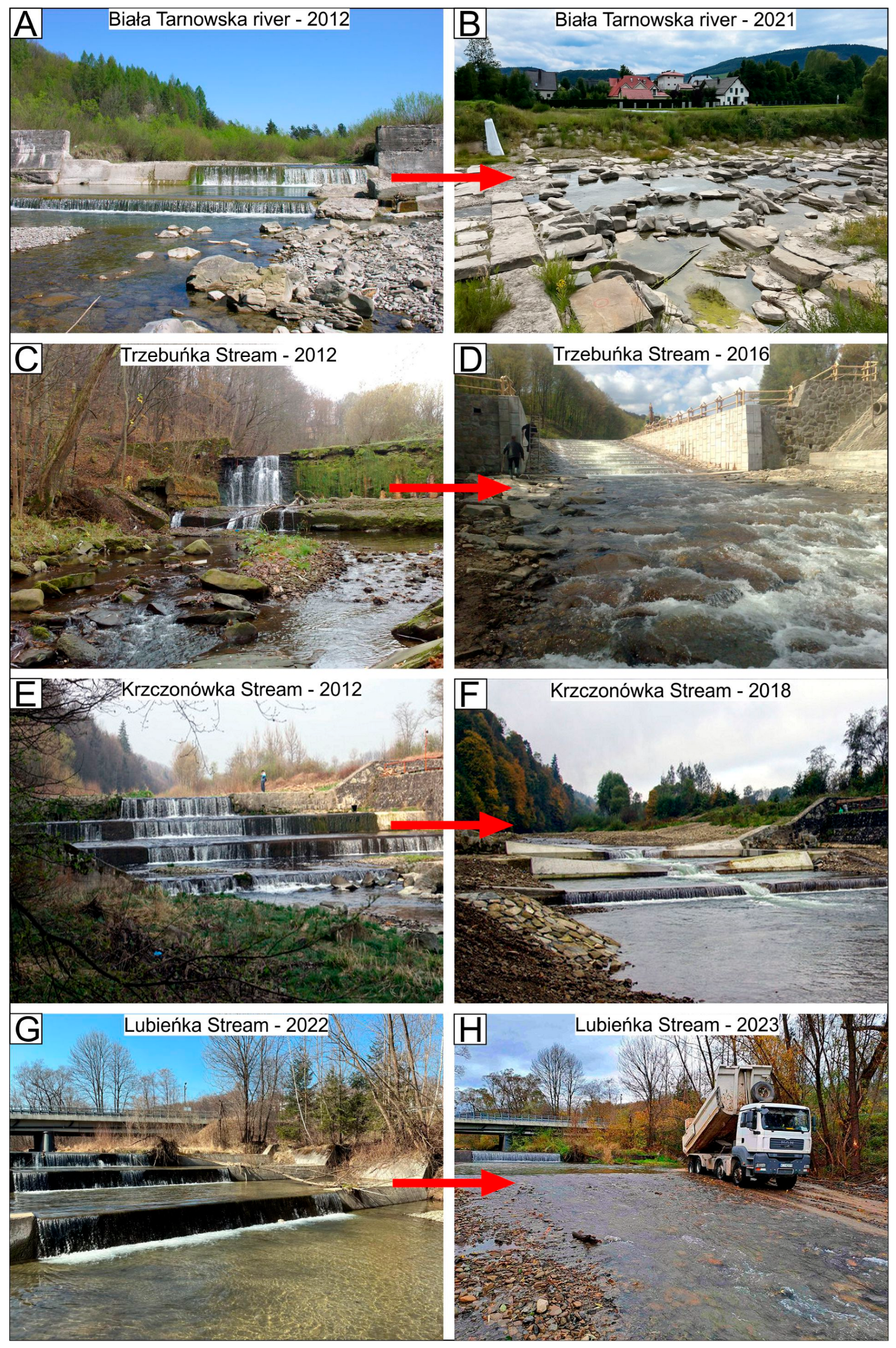Renaturalization Drives Hydromorphological Recovery in Degraded Gravel-Bed Streams in Poland
Abstract
1. Introduction
2. Materials and Methods
2.1. River Revitalization and Renaturalization
2.2. Analyzed Projects
- (i)
- Passive restoration techniques, e.g., erodible corridor, restoring the presence of vegetated islands, woody debris, and multi-thread channel patterns;
- (ii)
- Active restoration techniques, e.g., check dam/concrete weirs lowering, construction of fish passes, artificial riffles, roughened riffles and honeycomb-shape riffles, and reactivation of blocked braids.
2.3. Different Project Scales—One Goal
2.4. Case Study on the Czarny Dunajec River
2.5. Restoration Requires True Interdisciplinarity
3. Results
3.1. Passive Restoration Activities Conducted in Southern Poland
3.1.1. Erodible Corridor
3.1.2. Restoration of Multi-Thread Channel Pattern, with Bar-Braided or Island-Braided Morphology
3.1.3. Restoration of Large Woody Debris
3.1.4. Spontaneous River Renaturalization
3.2. Active Restoration Techniques
3.2.1. Check Dam/Concrete Weirs Lowering
3.2.2. Construction of Fish Passes
3.2.3. Reactivation of Blocked Braids/Side Channels
3.2.4. Artificial Riffles
3.2.5. Roughened Riffles and Honeycomb-Shape Riffles
- Stone riffles of the “honeycomb” type (Figure 7A,B), consisting of interconnected pools of irregular shape. Their walls are built from large, heavy boulders and include gaps and overflow sections that allow for migration;
- Cascade riffles, which, similarly to the structures mentioned above, are constructed from natural materials such as boulders and stone riprap. Their design consists of chambers separated by weir-like steps with gaps that enable migration;
- A cascade of progressively lowered barriers reducing impoundment, involving partial lowering of the step structure and the provision of appropriate migration conditions through the construction of a series of barriers with slots allowing the passage of aquatic organisms.
- Trzebuńka Stream, blocked by high check dam since 1935, was subjected to restoration within the project “The Upper Raba river spawning grounds” (Figure 7C,D). An 8 m-high dam was replaced with a 95 m-long structure, 65 m of which were built using so-called “grouted rock,” designed to resemble a natural rocky riverbed. The final design ensures full accessibility for people and all animal species, allowing unhindered migration along the stream. The structure can convey floodwaters and transport bedload, and its channel is dimensioned to accommodate very low, low, average, and high flows. During each of these flow conditions, the structure appears as though it were specifically designed for that state. It meets the requirements for stability, flood control, environmental compatibility, and enhanced amenity value.
3.2.6. Other Activities
4. Discussion
- What are we actually trying to achieve? Any project considered as river restoration must be sufficiently comprehensive to take into account the river’s real needs and to correctly assess its condition [54]. Each stakeholder has different expectations of the river: a scientist wants it to display good indicators of hydromorphological parameters and physical habitat conditions; an angler wants it to be rich in valuable fish species; local residents prioritize flood safety and the prevention of water spilling onto private land above all else; local water authorities face a lack of funding for comprehensive river management and must balance their actions to satisfy the interests of the above groups. As a result, many activities carried out under the banner of river maintenance are in practice minor regulatory works that do nothing to improve the state of the river.
- How successful are projects? Many restoration projects have demonstrated that even technically advanced interventions may yield only partial or short-lived ecological benefits. The large-scale restoration of the Skjern river (Denmark) successfully re-meandered the channel and reconnected former floodplains, yet post-implementation monitoring revealed that habitat diversity and ecological functions did not fully recover as anticipated due to altered hydromorphological processes and landscape constraints [55]. A similar pattern is evident in the Kissimmee river (Florida), where re-establishing a more natural channel layout partly improved wetland conditions and fish communities, but long-term hydrological management challenges and incremental implementation hindered full ecological recovery [56]. The removal of dams on the Elwha river in Washington State led to an eventual resurgence of migratory fish populations, yet in the short and medium term the sudden release of stored sediments caused major disturbances to channel structure and aquatic habitats, illustrating the complexity of translating physical reconnection into immediate ecological success [57]. Numerous case studies across European rivers, such as on the Horloff in Germany, further show that fragmented planning, insufficient catchment-scale coordination, and competing land-use pressures frequently limit restoration outcomes [58]. Broader reviews emphasize that many efforts are still evaluated too early or without long-term, process-based monitoring, leading to an overestimation of success and underestimation of underlying hydromorphological constraints [59].
- Uncertainty in the future development of the river channel. The mechanisms of fluvial processes in gravel-bed rivers allow them to shape their channels freely, even if they have been subject to regulatory works. This is a key reason why a river should have a suitably wide floodplain. For example, after the reactivation of blocked braids in the Czarny Dunajec river (see Section 3.2.3), the threat of erosion to a local road was permanently eliminated at that site. However, after the main active channel avulsed upstream of the study site during the May 2014 flood, bank erosion at another location began to threaten the nearby road. This suggests that, given the highly unstable flow regime in the multi-thread reach, a more effective management strategy may be to avoid interventions within the active river zone and instead reinforce channel banks locally where migrating channels approach valley-floor infrastructure.
- What does river restoration actually provide for the river and for people? Every responsible project implementer expects their actions to be effective and durable over many years. We hope that a restored river is not only natural but also visually appealing, safe, and a local asset. However, even when a large, comprehensive, and well-designed restoration project is carried out, we cannot be certain of the long-term durability of its outcomes. This is why long-term monitoring of restoration projects is particularly important in order to assess their real impact on improving river conditions. Research of this kind is currently being conducted on Carpathian watercourses and will be published upon completion. Sometimes, maintaining a river in good condition only requires the effective observance and enforcement of existing legislation. Many residents of riparian areas treat them as their private property, placing their own intentions above the law.
- Additional risks not previously considered. As our understanding of river systems develops, we are discovering further threats that were not previously assessed and are linked to freeing rivers from regulatory structures. Among these risks, particular attention should be paid to (i) secondary pollution of the river with heavy metals and other chemicals resulting from the erosion and redeposition of previously stabilized, regulated banks [19,20] and (ii) increased retention of macroplastics, especially in connection with woody debris in wide multi-thread river sections. Plastic subjected to mechanical abrasion in the water flow, cyclical UV exposure, and biochemical erosion becomes a source of secondary microplastics, which, moving freely through the ecosystem, enter living organisms [15,16].
5. Conclusions
Funding
Data Availability Statement
Acknowledgments
Conflicts of Interest
References
- Sawyer, A.H.; Cardenas, M.B.; Bomar, A.; Mackey, M. Impact of dam operations on hyporheic exchange in the riparian zone of a regulated river. Hydrol. Process. 2009, 23, 2129–2137. [Google Scholar] [CrossRef]
- Kondolf, G.M.; Boulton, A.J.; O’Daniel, S.; Poole, G.C.; Rahel, F.J.; Stanley, E.H.; Wohl, E.; Bång, A.; Carlstrom, J.; Cristoni, C.; et al. Process-Based Ecological River Restoration: Visualizing Three-Dimensional Connectivity and Dynamic Vectors to Recover Lost Linkages. Ecol. Soc. 2006, 11, 5. [Google Scholar] [CrossRef]
- Bennett, S.; Simon, J.; Castro, J.; Atkinson, C.; Bronner, S.; Rabideau, A. The evolving science of stream restoration. In Stream Restoration in Dynamic Fluvial Systems: Scientific Approaches, Analyses, and Tools; Geophysical Monograph Series; Simon, A., Bennett, S., Castro, J., Eds.; AGU: Washington, DC, USA, 2007; Volume 194, pp. 1–8. [Google Scholar] [CrossRef]
- Wohl, E.; Angermeier, P.L.; Bledsoe, B.; Kondolf, G.M.; MacDonnell, L.; Merritt, D.M.; Palmer, M.A.; Poff, N.L.; Tarboton, D. River restoration. Water Resour. Res. 2005, 41, W10301. [Google Scholar] [CrossRef]
- Wohl, E.; Lane, S.N.; Wilcox, A.C. The science and practice of river restoration. Water Resour. Res. 2015, 51, W10301. [Google Scholar] [CrossRef]
- RiverViki Map Powered by River Restoration Centre (UK). Available online: https://www.restorerivers.eu/wiki/index.php? (accessed on 15 October 2025).
- Szafraniec, B. Ujarzmianie Odry: Regulacja Rzeki w XIX Wieku w Obrębie Rejencji Opolskiej; Muzeum Śląska Opolskiego: Opole, Poland, 2014. [Google Scholar]
- Wyżga, B.; Zawiejska, J.; Radecki-Pawlik, A.; Hajdukiewicz, H. Environmental change, hydromorphological reference conditions and the restoration of Polish Carpathian rivers. Earth Surf. Process. Landf. 2012, 37, 1213–1226. [Google Scholar] [CrossRef]
- Gorczyca, E. Rozwój Górskich Żwirodennych Koryt Rzecznych w Warunkach Antropopresji; Wydawnictwo IGiGP UJ: Kraków, Poland, 2016. [Google Scholar]
- Hajdukiewicz, H.; Wyżga, B.; Amirowicz, A.; Oglęcki, P.; Radecki-Pawlik, A.; Zawiejska, J.; Mikuś, P. Ecological state of a mountain river before and after a large flood: Implications for river status assessment. Sci. Total Environ. 2018, 610–611, 244–257. [Google Scholar] [CrossRef]
- Wyżga, B. A review on channel incision in the Polish Carpathian rivers during the 20th century. Dev. Earth Surf. Process. 2007, 11, 525–553. [Google Scholar] [CrossRef]
- Stanford, J.A.; Ward, J.V.; Liss, W.J.; Frissell, C.A.; Williams, R.N.; Lichatowich, J.A.; Coutant, C.C. A general protocol for restoration of regulated rivers. Regul. Rivers Res. Manag. 1996, 12, 391–413. [Google Scholar] [CrossRef]
- Mikuś, P.; Wyżga, B.; Radecki-Pawlik, A.; Zawiejska, J.; Amirowicz, A.; Oglęcki, P. Environment-friendly reduction of flood risk and infrastructure damage in a mountain river: Case study of the Czarny Dunajec. Geomorphology 2016, 272, 43–54. [Google Scholar] [CrossRef]
- Gallitelli, L.; Scalici, M. Riverine macroplastic gradient along watercourses: A global overview. Front. Environ. Sci. 2022, 10, 937944. [Google Scholar] [CrossRef]
- Liro, M.; Mikuś, P.; Wyzga, B. First insight into the macroplastic storage in a mountain river: The role of in-river vegetation cover, wood jams and channel morphology. Sci. Total Environ. 2022, 838, 156354. [Google Scholar] [CrossRef] [PubMed]
- Liro, M.; van Emmerik, T.H.M.; Zielonka, A.; Gallitelli, L.; Mihai, F.C. The unknown fate of macroplastic in mountain rivers. Sci. Total Environ. 2023, 865, 161224. [Google Scholar] [CrossRef]
- Viviroli, D.; Dürr, H.H.; Messerli, B.; Meybeck, M.; Weingartner, R. Mountains of the world, water towers for humanity: Typology mapping, and global significance. Water Resour. Res. 2007, 43, 7. [Google Scholar] [CrossRef]
- Margenat, H.; Ruiz-Orejón, L.F.; Cornejo, D.; Martí, E.; Vila, A.; Le Roux, G.; Hansson, S.; Guasch, H. Guidelines of Field-Tested Procedures and Methods for Monitoring Plastic Litter in Mountain Riverine Systems (PLASTICØPYR Project); European Commission: Luxembourg, 2021. [Google Scholar]
- Khosrovyan, A. The Ecological Effects of Micro(nano)plastics in the Water Environment. Water 2024, 16, 2020. [Google Scholar] [CrossRef]
- Khosrovyan, A. Biodiversity and Ecosystem Services in Rivers. Water 2024, 16, 2091. [Google Scholar] [CrossRef]
- Riba, I.; Gabrielyan, B.; Khosrovyan, A.; Luque, A.; Del Valls, T.A. The influence of ph and waterborne metals on egg fertilization of the blue mussel (Mytilus edulis), the oyster (Crassostrea gigas) and the sea urchin (Paracentrotus lividus). Environ. Sci. Pollut. Res. 2016, 23, 14580–14588. [Google Scholar] [CrossRef]
- WWF Poland. Krajowy Program Renaturyzacji Wód Powierzchniowych (National Programme for Surface Water Restoration). WWF Polska, 2023. Available online: https://www.wwf.pl/krajowy-program-renaturyzacji-wod (accessed on 9 November 2025).
- Supreme Audit Office (Najwyższa Izba Kontroli, NIK). Stan wód w Polsce. NIK, 2025. Available online: https://www.nik.gov.pl/najnowsze-informacje-o-wynikach-kontroli/stan-wod-w-polsce-2025.html (accessed on 9 November 2025).
- Morandi, B.; Cottet, M.; Piégay, H. River Restoration: Political, Social, and Economic Perspectives; Wiley-Blackwell: Hoboken, NJ, USA, 2021. [Google Scholar]
- Lüderitz, V.; Jüpner, R.; Müller, D.; Feld, C.K. Renaturalization of streams and rivers—The special importance of integrated ecological methods in measurement of success. An example from Saxony-Anhalt (Germany). Limnologica 2004, 34, 249–263. [Google Scholar] [CrossRef]
- Kuhlmann, F.; Balicka, J.; Wilczyńska, A. Urban river revitalisation. In Urban Blue Spaces Planning and Design for Water, Health and Well-Being; Bell, S., Fleming, L.E., Grellier, J., Kuhlmann, F., Nieuwenhuijsen, M.J., White, M.P., Eds.; Routledge: London, UK, 2021; pp. 239–287. [Google Scholar]
- Environmental Protection Agency. Available online: https://www.epa.gov/healthresearch/remediation-restoration-revitalization (accessed on 15 October 2025).
- PN-EN 14614:2020; Jakość wody—Wytyczne do oceny hydromorfologicznych cech rzek. Polski Komitet Normalizacyjny: Warszawa, Poland, 2020.
- Gurnell, A.M.; Grabowski, R.C. An Example Application of the CEN Water Quality—Guidance Standard for Assessing the Hydromorphological Features of Rivers to the River Frome, Dorset, Southern England; UK Centre for Ecology and Hydrology: Wallingford, UK, 2020. [Google Scholar]
- Gurnell, A.M.; Rinaldi, M.; Belletti, B.; Bizzi, S.; Blamauer, B.; Braca, G.; Buijse, A.D.; Bussettini, M.; Camenen, B.; Comiti, F.; et al. A multi-scale hierarchical framework for developing understanding of river behaviour to support river management. Aquat. Sci. 2016, 78, 1–16. [Google Scholar] [CrossRef]
- Rosgen, D.L. A classification of natural rivers. Catena 1994, 22, 169–199. [Google Scholar] [CrossRef]
- Thorne, C.R.; Hey, R.D.; Newson, M.D. Applied Fluvial Geomorphology for River Engineering and Management; Wiley: Chichester, UK, 1997. [Google Scholar]
- Jeleński, J. Przykłady wykorzystania równań Hey’a-Thorne’a do oceny stanu koryt rzek górskich i planowania robót utrzymaniowych. In Problemy Planowania w Gospodarce Wodnej i Oceny Stanu Hydromorfologicznego Rzek; Walczykiewicz, T., Ed.; Wydawnictwo IMGW-PIB: Warszawa, Poland, 2016; pp. 227–252. [Google Scholar]
- Jeleński, J.; Wyżga, B. Możliwe Techniczne i Biologiczne Interwencje w Utrzymaniu Rzek Górskich; Stowarzyszenie “Ab Ovo”: Kraków, Poland, 2016. [Google Scholar]
- Krakowskie Przedsiębiorstwo Budownictwa Wodno-Inżynieryjnego (KPBWI). Roboty Regulacyjne na Potoku Czarny Dunajec w Długopolu; KPBWI: Kraków, Poland, 1974. [Google Scholar]
- Wyżga, B.; Oglęcki, P.; Hajdukiewicz, H.; Zawiejska, J.; Radecki-Pawlik, A.; Skalski, T.; Mikuś, P. Interpretation of the invertebrate-based BMWP-PL index in a gravel-bed river: Insight from the Polish Carpathians. Hydrobiologia 2013, 712, 71–88. [Google Scholar] [CrossRef]
- Mikuś, P.; Wyżga, B.; Kaczka, R.J.; Walusiak, E.; Zawiejska, J. Islands in a European mountain river: Linkages with large wood deposition, flood flows and plant diversity. Geomorphology 2013, 202, 115–127. [Google Scholar] [CrossRef]
- Mikuś, P.; Wyżga, B.; Walusiak, E.; Radecki-Pawlik, A.; Liro, M.; Hajdukiewicz, H.; Zawiejska, J. Island development in a mountain river subjected to passive restoration: The Raba River, Polish Carpathians. Sci. Total Environ. 2019, 660, 406–420. [Google Scholar] [CrossRef]
- Wyżga, B.; Liro, M.; Mikuś, P.; Zawiejska, J.; Plesiński, K.; Jeleński, J.; Radecki-Pawlik, A. Changes of fluvial processes caused by the restoration of an incised mountain stream. Ecol. Eng. 2021, 168, 106286. [Google Scholar] [CrossRef]
- Mikuś, P.; Wyżga, B.; Bylak, A.; Kukuła, K.; Liro, M.; Oglęcki, P.; Radecki-Pawlik, A. Impact of the restoration of an incised mountain stream on habitats, aquatic fauna and ecological stream quality. Ecol. Eng. 2021, 170, 106365. [Google Scholar] [CrossRef]
- Geist, J.; Hawkins, S. Habitat recovery and restoration in aquatic ecosystems: Current progress and future challenges. Aquat. Conserv. Mar. Freshw. Ecosyst. 2016, 26, 942–962. [Google Scholar] [CrossRef]
- Haase, P.; Hering, D.; Jähnig, S.C.; Lorenz, A.W.; Sundermann, A. The impact of hydromorphological restoration on river ecological status: A comparison of fish, benthic invertebrates, and macrophytes. Hydrobiologia 2013, 704, 475–488. [Google Scholar] [CrossRef]
- Palmer, M.A.; Menninger, H.L.; Bernhardt, E. River restoration, habitat heterogeneity and biodiversity: A failure of theory or practice? Freshw. Biol. 2010, 55, 205–222. [Google Scholar] [CrossRef]
- Parasiewicz, P.; Belka, K.; Łapińska, M.; Ławniczak, K.; Prus, P.; Adamczyk, M.; Buras, P.; Szlakowski, J.; Kaczkowski, Z.; Krauze, K.; et al. Over 200,000 kilometers of free-flowing river habitat in Europe is altered due to impoundments. Nat. Commun. 2023, 14, 6289. [Google Scholar] [CrossRef]
- Garcia de Leaniz, C.; Wantzen, K.M.; Wolter, C.; Tharme, R.E.; Zalewski, M.; Belletti, B. Editorial: Challenges and benefits of restoring river connectivity. Front. Ecol. Evol. 2020, 11, 1110413. [Google Scholar] [CrossRef]
- Wyżga, B.; Amirowicz, A.; Bednarska, A.; Bylak, A.; Hajdukiewicz, H.; Kędzior, R.; Kukuła, K.; Liro, M.; Mikuś, P.; Oglęcki, P.; et al. Scientific monitoring of immediate and long-term effects of river restoration projects in the Polish Carpathians. Ecohydrol. Hydrobiol. 2021, 21, 244–255. [Google Scholar] [CrossRef]
- Wyżga, B.; Zawiejska, J.; Radecki-Pawlik, A. Impact of channel incision on the hydraulics of flood flows: Examples from Polish Carpathian rivers. Geomorphology 2016, 272, 10–20. [Google Scholar] [CrossRef]
- Jeleński, J.; Mikuś, P. Zastosowanie przyjaznego środowisku podejścia inżynierskiego do ograniczania ryzyka powodzi na przykładzie regulacji odcinka rzeki Bóbr w Wojanowie. Gospod. Wodna 2016, 4, 101–109. [Google Scholar]
- Urbanič, G.; Mihaljević, Z.; Petkovska, V.; Urbanič, P.M. Back to Ecology: Reference Conditions as a Basis for Assessment, Restoration and Sustainable Management of Large Rivers. Water 2021, 13, 2596. [Google Scholar] [CrossRef]
- Wiejaczka, Ł.; Kijowska-Strugała, M. Hydromorphological state of Carpathian rivers. Water Environ. J. 2015, 29, 277–287. [Google Scholar] [CrossRef]
- Nestler, J.C.; Lubinski, K.; Smith, D. Reference condition approach to restoration planning. River Res. Appl. 2010, 26, 1199–1219. [Google Scholar] [CrossRef]
- Szałkiewicz, E.; Jusik, S.; Grygoruk, M. Status of and perspectives on river restoration in Europe: 310,000 Euros per hectare of restored river. Sustainability 2018, 10, 129. [Google Scholar] [CrossRef]
- Johnson, M.F.; Thorne, C.R.; Castro, J.M.; Kondolf, G.M.; Mazzacano, C.S.; Rood, S.B.; Westbrook, C. Biomic river restoration: A new focus for river management. River Res. Appl. 2020, 36, 3–12. [Google Scholar] [CrossRef]
- Belletti, B.; Garcia de Leaniz, C.; Jones, J.; Bizzi, S.; Börger, L.; Segura, G.; Castelletti, A.; Van de Bund, W.; Aarestrup, K.; Barry, J.; et al. More than one million barriers fragment Europe’s rivers. Nature 2020, 588, 436–441. [Google Scholar] [CrossRef]
- Kristensen, E.A.; Kronvang, B.; Wiberg-Larsen, P.; Thodsen, H.; Nielsen, C.; Amor, E.; Friberg, N.; Pedersen, M.L.; Baattrup-Pedersen, A. 10 years after the largest river restoration project in Northern Europe: Hydromorphological changes on multiple scales in River Skjern. Ecol. Eng. 2014, 66, 141–149. [Google Scholar] [CrossRef]
- Whalen, P.J.; Toth, L.A.; Koebel, J.W.; Kissimmee, P.K. River restoration: A case study. Water Sci. Technol. 2002, 45, 55–620. [Google Scholar] [CrossRef]
- Bednarek, A. Undamming Rivers: A Review of the Ecological Impacts of Dam Removal. Environ. Manag. 2001, 27, 803–814. [Google Scholar] [CrossRef] [PubMed]
- Schürings, C.; Kaijser, W.; Gillmann, S.M.; Kiesel, J.; Nguyen, H.H.; Peters, K.; Rolauffs, P.; Haase, P.; Lorenz, A.W.; Hering, D. Drivers of recovery and degradation of riverine benthic invertebrate communities: A Germany-wide analysis. Ecol. Process. 2025, 14, 30. [Google Scholar] [CrossRef]
- Bernhardt, E.; Palmer, M. Evaluating River Restoration. Ecol. Appl. 2011, 21, 1925. [Google Scholar] [CrossRef]







| Number (Figure 2) | River/Stream | Catchment Area [km2] | Mean Annual Flow | Main Channel Width [m] | Floodplain Width [m] | Type of Measurement | Scope of Works | Implementation Status | Restored Stream Length [km] |
|---|---|---|---|---|---|---|---|---|---|
| 1 | Bóbr R. | 535 | 6.0 | 5.0 | 220 | Revitalization | Artificial riffles | Completed (2014–2015) | 6 |
| 2 | Kaczawa R. | 1799 | 8.4 | 18 | 760 | Revitalization | Neutralizing of weirs and steps | Project prepared, no implementation | 58 |
| 3 | Odra R. | 19,684 | 300 | 110 | 1270 | Revitalization | Improving sewage management | Approved in the form of a government act (2023) | entire river course |
| 4 | Odra R. | 4659 | 42 | 48 | 580 | Renaturalization | Erodible corridor | Completed (2004) | 7 |
| 5 | Odra R. | 7800 | 65 | 53 | 670 | Renaturalization | Widening the river embankment | Completed (2015) | 5 |
| 6 | Czechowicki S. | 8.4 | 0.12 | 3.3 | 38 | Revitalization | Natural flood protection | Completed (2020) | 4 |
| 7 A–C | Vistula R. | 1774 | 35 | 21 | 480 | Revitalization | Restoring 3 oxbow lakes | Completed (2016) | 3 |
| 8 A–B | Soła R. | 1358 | 15 | 23 | 370 | Revitalization | Fish pass | Completed (2023) | 0.1 |
| 9 A–B | Vistula R. | 2550 | 47 | 24 | 550 | Revitalization | Fish pass | Completed (2023) | 0.1 |
| 10 A–C | Skawa R. | 466 | 8.2 | 25 | 473 | Revitalization | Fish pass | Completed (2023) | 0.1 |
| 11 | Raba R. | 644 | 10.7 | 18 | 425 | Renaturalization | Erodible corridor + Restoration of the stream longitudinal continuity | Completed (2010) | 3.5 |
| 12 | Trzebuńka S. | 6 | 0.3 | 6 | 35 | Revitalization | Restoration of the stream longitudinal continuity | Completed (2016) | 6 |
| 13 | Krzczonówka S. | 88 | 1.5 | 12 | 84 | Renaturalization | Restoration of the stream longitudinal continuity | Completed (2016) | 2 |
| 14 | Lubieńka S. | 47 | 0.6 | 7 | 21 | Revitalization | Restoration of the stream longitudinal continuity | Completed (2023) | 0.3 |
| 15 | Czarny Dunajec R. | 200 | 4.3 | 23 | 440 | Revitalization | Proving the relevance of wooded islands in multi-thread rivers | Completed (2011) | 3.5 |
| 16 | Czarny Dunajec R. | 220 | 4.4 | 22 | 450 | Revitalization | Reactivation of blocked braids | Completed (2013) | 0.5 |
| 17 | Krzyworzeka S. | 77 | 1.2 | 15 | 30 | Renaturalization | floodplain widening + artificial riffles | Planned | entire stream course |
| 18 | Kamienica Nawojowska R. | 64 | 1.1 | 12 | 65 | Revitalization | Neutralizing of weirs and steps | In progress (2023- present) | 12 |
| 19 | Biała Tarnowska R. | 206 | 2.8 | 20 | 200 | Renaturalization | Erodible corridor + Restoration of the stream longitudinal continuity | Completed (2014) | 20.4 |
| 20 | Biała Tarnowska R. | 523 | 5.8 | 28 | 440 | Revitalization | Neutralizing of weirs and steps | Completed (2020) | entire river course |
| 21 | Ropa R. | 484 | 4.4 | 31 | 480 | Revitalization | Fish passes/artificial riffles | Completed (2020) | entire river course |
| 22 | Sękówka S. | 122 | 1.9 | 13 | 210 | Revitalization | Lowering of the barrage | In progress (2024-present) | 0.1 |
| 23A-C | Wisłoka R. | 2550 | 28 | 54 | 1090 | Revitalization | Fish passes | Completed (2020) | entire river course |
| 24 | Jasiołka S. | 512 | 6 | 19 | 260 | Revitalization | Fish passes | Completed (2020) | entire stream course |
| 25 | Tanew R. | 725 | 3.5 | 18 | 73 | Revitalization | Artificial riffles, river feeding | Completed (2022) | 0.5 |
| 26 | Sopot S. | 85 | 0.15 | 12 | 48 | Revitalization | Artificial riffles | Completed (2021) | 0.3 |
| 27 | Niepryszka S. | 30.5 | 0.15 | 5.5 | 26 | Renaturalization | Artificial riffles | Planned | entire stream course |
Disclaimer/Publisher’s Note: The statements, opinions and data contained in all publications are solely those of the individual author(s) and contributor(s) and not of MDPI and/or the editor(s). MDPI and/or the editor(s) disclaim responsibility for any injury to people or property resulting from any ideas, methods, instructions or products referred to in the content. |
© 2025 by the author. Licensee MDPI, Basel, Switzerland. This article is an open access article distributed under the terms and conditions of the Creative Commons Attribution (CC BY) license (https://creativecommons.org/licenses/by/4.0/).
Share and Cite
Mikuś, P. Renaturalization Drives Hydromorphological Recovery in Degraded Gravel-Bed Streams in Poland. Water 2025, 17, 3315. https://doi.org/10.3390/w17223315
Mikuś P. Renaturalization Drives Hydromorphological Recovery in Degraded Gravel-Bed Streams in Poland. Water. 2025; 17(22):3315. https://doi.org/10.3390/w17223315
Chicago/Turabian StyleMikuś, Paweł. 2025. "Renaturalization Drives Hydromorphological Recovery in Degraded Gravel-Bed Streams in Poland" Water 17, no. 22: 3315. https://doi.org/10.3390/w17223315
APA StyleMikuś, P. (2025). Renaturalization Drives Hydromorphological Recovery in Degraded Gravel-Bed Streams in Poland. Water, 17(22), 3315. https://doi.org/10.3390/w17223315






